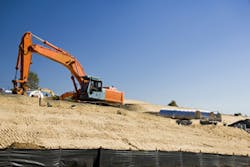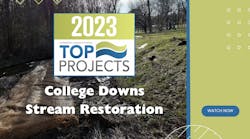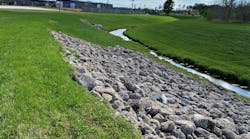When it comes to versatility, erosion control contractors rely on silt fence and wattles—or other rolled or berm-shaped filtration products—as the workhorses of a job site. They are used as sediment barriers, as check dams to slow the flow of water and sediment (placed perpendicular to the downhill flow of the water), and as perimeter guards around construction sites. They are sometimes placed around inlets to stop sediment and debris from entering the storm drain.
Wattles are commonly made from natural fiber like straw, rice straw, or coir and often encased in some type of netting, although companies such as Filtrexx International manufacture geotextile tubes filled with compost. Sandbags and gravel bags also are used for sediment control.
Wattles that are biodegradable can be left on the site once the work is done. They are commonly used in fire-affected areas—especially on slopes and hillsides—to trap soil and sediment left exposed after a wildfire.
The most commonly used sediment control product on construction sites is silt fence. Newer types of silt fence and new mechanical installation methods have come on the market. Yet even some common sediment control devices have come under fire for failing due to improper installation.
That was a painful lesson for Mike Zock, who operates Mazcon near Pittsburgh, PA. He discovered early on that there’s a high price to be paid for improperly functioning silt fence—figuratively and literally.
“We’re former high-tech engineering type people,” he says of the company he started seven years ago. “There are not very many of us, but we do project management and business development, and we started getting into residential development, which was a big thing to get into at the time,” he says.
There were many affordable housing projects and residential development—a lot of business growth. His company started handling residential developments and managing projects for large developers. Along the way, the company was introduced to site work, stormwater management, erosion control, pipe installation, and earthmoving.
Then came a few projects where the silt fence the company had been using failed.
“Right out of the chute, we really got our clocks cleaned out on a couple of jobs where silt fence failed,” Zock says. “We had gotten shut down.
“We were supposed to be managing the schedule, making sure people get paid, and we’ve got this wonderfully engineered plan that developers paid big money to get designed, engineered, and approved. At the end of the day, the best insurance they’ve got in the field is silt fence, and it was woefully inadequate.”
At that point, Zock’s company began investigating alternatives.
“We looked at various things, including straw wattles and compost filter sock. We kept going back to compost filter sock—to its weight, its mass, the fact that it can be recycled.”
The company began using compost filter socks in 2006—specifically, Filtrexx’s SiltSoxx—and hasn’t been fined since.
SiltSoxx came on the market about five years ago and recently became available on pallets. That enables contractors such as Zock to rely on other installation methods than a blower truck.
“Although this competes somewhat with wattles, we really do not see wattles that much here in the East,” says Rod Tyler, chief executive officer of Filtrexx. “Wattles, silt fence, and our SiltSoxx all compete for sediment control applications.”
Zock says he finds SiltSoxx to be a heavier-weight product that moves less, requires less staking, and is successful in filtering. The 150-foot sections are fast and efficient to install. The continuous sections offer him less concern about overlap and less chance of getting fines, he adds. “At the end of the day, it’s easier to install and it’s going to create a situation where you’re less likely to have a failure.”
“We’ve had great protection, and we’ve done some very interesting projects,” Zock notes.
The state of Pennsylvania is specifying compost filter sock on an increasing basis, he says. One project in Pennsylvania is the Marcellus Shale for gas exploration. This unit of marine sedimentary rock contains a large amount of untapped natural gas reserves.
The Marcellus Shale encompasses lower New York to Pennsylvania, extends south into West Virginia, and includes some of western Maryland and eastern Ohio.
“It is explosive in terms of business in the amount of natural gas that’s being produced and the amount of site work that’s being done,” says Zock.
In early 2008, the Pennsylvania Department of Environmental Protection agreed to use compost filter sock on that site, Zock says.
“We took that cue to begin aggressively talking with engineers, developers, and regulatory people about the importance of compost filter sock. In Pennsylvania, as of the end of 2010, 2.4 million feet of compost filter sock had been used for perimeter control,” he says.
That’s a switch from earlier times, he says, when “if you put in something that wasn’t silt fence, people questioned you. Today, the norm in many cases in Pennsylvania is compost filter sock, and what’s interesting about it is that many questions have been answered about the viability of this ramp-up of the technology in terms of its proliferation, its scalability, feedstocks, pricing, distribution, and longevity in the field.
“Pennsylvania has proven that all of those questions are answered satisfactorily with 440 miles of compost filter sock going down in this state in 2010. That’s a whole lot of erosion control and perimeter control, and it’s working well.”
Zock is taking the story of success of compost filter sock in Pennsylvania to surrounding states where site work will be done on Marcellus Shale, as well as to other states. He says while some compare SiltSoxx to straw wattles, he does not draw that comparison. “Straw wattles are much lighter, they break down faster, and there’s a lot of hand work involved,” he says. “You don’t have any of that with compost filter sock.”
He also likes that SiltSoxx is available nationally on pallets as a commodity product through distributors. His company now not only installs the product, but also distributes it.






